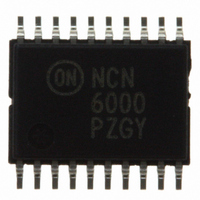NCN6000DTBR2 ON Semiconductor, NCN6000DTBR2 Datasheet - Page 7

NCN6000DTBR2
Manufacturer Part Number
NCN6000DTBR2
Description
IC INTERFACE SMART CARD 20TSSOP
Manufacturer
ON Semiconductor
Datasheet
1.NCN6000DTBR2.pdf
(36 pages)
Specifications of NCN6000DTBR2
Applications
ATM Terminals, Gas Pumps, ISM
Interface
Microcontroller
Voltage - Supply
2.7 V ~ 6 V
Package / Case
20-TSSOP
Mounting Type
Surface Mount
Lead Free Status / RoHS Status
Contains lead / RoHS non-compliant
Other names
NCN6000DTBR2OSTR
Available stocks
Company
Part Number
Manufacturer
Quantity
Price
Part Number:
NCN6000DTBR2
Manufacturer:
ON/安森美
Quantity:
20 000
Part Number:
NCN6000DTBR2G
Manufacturer:
ON/安森美
Quantity:
20 000
PIN FUNCTIONS AND DESCRIPTION (continued)
Pin
10
12
13
14
15
16
17
18
11
8
9
CLOCK_IN
PWR_GND
CRD_DET
CRD_RST
CRD_VCC
CRD_CLK
GROUND
CRD_IO
Lout_L
Name
INT
I/O
High Impedance
CLOCK INPUT
Input/Output
Pull Down
OUTPUT
OUTPUT
OUTPUT
POWER
SIGNAL
POWER
POWER
Pull Up
INPUT
Type
I/O
This pin is connected to an external microcontroller interface. A bidirectional level translator
adapts the serial I/O signal between the smart card and the microcontroller. The level
translator is enabled when CS = L. The signal present on this pin is latched when CS = H.
This pin is also used in programming mode (Tables 1, 2 and 3, Figures 4 and 5).
This pin is activated LOW when a card has been inserted and detected by the interface or
when the NCN6000 reports Vbat or CRD_VCC status (See Table 6). The signal is reset to
a logic 1 on the rising edge of either CS or PWR_ON. The Collector open mode makes
possible the wired AND/OR external logic. When two or more interfaces share the INT
function with a single microcontroller, the software must poll the STATUS pin to identify the
origin of the interrupt (Figure 5).
This pin can be connected to either the microcontroller master clock, or to any clock signal,
to drive the external smart cards. The signal is fed to internal clock selector circuit and
translated to the CRD_CLK pin at either the same frequency, or divided by 2 or 4 or 8,
depending upon the programming mode (Tables 1, 2 and 3).
Care must be observed, at PCB level, to minimize the pick−up noise coming from the
CLOCK_IN line. It is recommended to put a shield, built with a 10 mil copper track, around
this line and terminated to the GND.
The signal coming from the external card connector is used to detect the presence of the
card. A built−in pull up low current source makes this pin active LOW or HIGH, assuming
one side of the external switch is connected to ground. At Vbat start up, the default
condition is Normally Open switch, negative going insertion detection. The Normally
Closed switch, positive going insertion detection, can be defined by programming the
NCN6000 accordingly. In this case, the polarity must be set up during the first cycles of the
system initialization, otherwise an already inserted card will not be detected by the chip.
This pin is connected to the RESET pin of the card connector. A level translator adapts the
RESET signal from the microcontroller to the external card. The output current is internally
limited to 15 mA. The CRD_RST is validated when PWR_ON = H and PGM = H and hard
wired to Ground when the card is deactivated.
This pin is connected to the CLK pin of the card connector. The CRD_CLK signal comes
from the clock selector circuit output. Combining A0, A1, PGM and I/O, as depicted in
Table 3 and Figure 3, programs the clock selection. This signal can be forced into a
standby mode with CRD_CLK either High or Low, depending upon the mode defined by
the programming sequence (Tables 1, 2 and 3 and Figure 4).
Care must be observed, at PCB level, to minimize the pick−up noise coming from the
CRD_CLK line. It is recommended to put a shield, built with a 10mil copper track, around
this line and terminated to the GND.
This pin handles the connection to the serial I/O pin of the card connector. A bidirectional
level translator adapts the serial I/O signal between the card and the microcontroller. The
CRD_IO pin current is internally limited to 15 mA. A built−in register holds the previous
state presents on the I/O input pin.
This pin provides the power to the external card. It is the logic level “1” for CRD_IO,
CRD_RST and CRD_CLK signals. The energy stored by the DC−DC external inductor
Lout must be smoothed by a 10 mF capacitor, associated with a 100 nF ceramic in parallel,
connected across CRD_VCC and GND. In the event of a CRD_VCC U
NCN6000 detects the situation and feedback the information in the STATUS bit. The device
does not take any further action, particularly the DC−DC converter is neither stopped nor
reprogrammed by the NCN6000. It is up to the external MPU to handle the situation.
However, when the CRD_VCC is overloaded, the NCN6000 shut off the DC−DC converter,
pulls the INT pin Low and reports the fault in the STATUS register.
The logic and low level analog signals shall be connected to this ground pin. This pin must
be externally connected to the PWR_GND pin 17. The designer must make sure no high
current transients are shared with the low signal currents flowing into this pin.
This pin is the Power Ground associated with the built−in DC−DC converter and must be
connected to the system ground together with GROUND pin 11. Using good quality ground
plane is recommended to avoid spikes on the logic signal lines.
The High Side of the external inductor is connected between this pin and Lout_H to provide
the DC−DC function. The built−in MOS devices provide the switching function together with
the CRD_VCC voltage rectification.
http://onsemi.com
NCN6000
7
Description
VLOW
voltage, the











